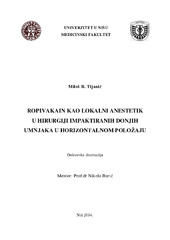Приказ основних података о дисертацији
Ropivakain kao lokalni anestetik u hiruriji impaktiranih donjih umnjaka u horizontalnom položaju
Ropivacaine as local anesthetic in surgery of impacted lower wisdom teeth in horizontal position
| dc.contributor.advisor | Burić, Nikola | |
| dc.contributor.other | Jovanović, Goran | |
| dc.contributor.other | Petrović, Dragan | |
| dc.contributor.other | Janković, Radmilo | |
| dc.contributor.other | Marković, Alkesa | |
| dc.creator | Tijanić, Miloš R. | |
| dc.date.accessioned | 2016-01-05T13:22:58Z | |
| dc.date.available | 2016-01-05T13:22:58Z | |
| dc.date.available | 2020-07-03T16:06:36Z | |
| dc.date.issued | 2014-07-04 | |
| dc.identifier.uri | https://nardus.mpn.gov.rs/handle/123456789/3949 | |
| dc.identifier.uri | http://eteze.ni.ac.rs/application/showtheses?thesesId=1748 | |
| dc.identifier.uri | https://fedorani.ni.ac.rs/fedora/get/o:951/bdef:Content/download | |
| dc.identifier.uri | http://vbs.rs/scripts/cobiss?command=DISPLAY&base=70052&RID=1024957677 | |
| dc.description.abstract | Surgical extraction of impacted lower wisdom teeth is accompanied by severe pain in the postoperative period, especially in the first hours after the intervention. Therefore, the use of long-acting local anesthetics is preferred in the case of surgical extraction of impacted lower wisdom teeth. Ropivacaine is a long-acting amide local anesthetic, structurally similar to bupivacaine. Numerous clinical studies suggest lower cardiotoxicity as well as CNS toxicity of ropivacaine when compared to bupivacaine and its significant characteristic can be that, in contrast to other synthesized local anesthetics, it causes vasoconstriction in the application site. The aim of our study was to evaluate the anesthetic effect of the local anesthetic 0.75% ropivacaine and its effect on the intraoperative hemostasis during a surgical extraction of impacted lower wisdom teeth in horizontal position. Furthermore, the aim of the research was also to compare the anesthetic effect of 0.75% ropivacaine, 0.5% bupivacaine and 2% lidocaine with adrenaline during surgical extraction of impacted lower wisdom teeth in horizontal position, as well as their analgesic effect in the postoperative period. The investigation was conducted on the patients of the Department of Oral Surgery, Clinic of Dentistry in Niš, in whom the surgical extraction of impacted lower wisdom teeth in horizontal position was indicated. The total number of patients was 90, and all the patients were divided into three equal groups, 30 patients each. In the first, study group, 0.75% ropivacaine HCL was applied preoperatively; in the second, control group, 0.5% bupivacaine HCL was given; and in the third, control group, 2% lidocaine with adrenaline was administered. The anesthetic was applied by the direct technique of intraoral infiltration anesthesia of N. alveolaris inferior (1.5 ml) and N. lingualis (0.3 ml), as well as by the technique of plexus anesthesia of N. bucalis (0.2 ml). In order to conduct the comparative analysis of the local anesthetics’ effects, the following parameters were followed in each of the patients: time of the anesthesia effect beginning, duration of anesthesia, quality of anesthesia (by using the table for the evaluation of anesthesia quality by Sisk), degree of intraoperative hemorrhage (evaluation by Meechan scale), intensity of pain during the intervention (applying the visual analogue scale), time of the onset and intensity of postoperative pain, as well as the number of analgesics taken during the postoperative period. The results obtained in clinical trials of 0.75% solution of ropivacaine indicate that this local anesthetic could be successfully used to achieve local infiltration anesthesia (mandibular anesthesia) in oral surgical interventions. This conclusion is suggested by the anesthesia parameters obtained in this study: the anesthesia frequency of 93.3%, the start of anesthetic effect - latent period of 2.5 minutes, a good quality of anesthesia, as well as the duration of anesthetic effect of nearly 7 hours (412 minutes). After the administration of ropivacaine, a statistically significant improvement in quality of anesthesia is achieved as compared to bupivacaine, while in comparison with lidocaine it showed a statistically significantly better analgesic effect. The overall impression after the conducted study is that 0.75% solution of ropivacaine can be successfully used as a local anesthetic at the surgical extraction of impacted lower wisdom teeth. Moreover, the 0.75% ropivacaine could be equally effectively used in other oral surgical procedures when there is an indication (long lasting interventions, interventions followed by intensive postoperative pains, the anesthetic without a vasoconstrictor). | en |
| dc.format | application/pdf | |
| dc.language | sr | |
| dc.publisher | Универзитет у Нишу, Медицински факултет | sr |
| dc.rights | openAccess | en |
| dc.rights.uri | https://creativecommons.org/licenses/by-nc-nd/4.0/ | |
| dc.source | Универзитет у Нишу | sr |
| dc.subject | Oralna hirurgija | sr |
| dc.subject | ropivacaine | en |
| dc.subject | ropivakain | sr |
| dc.subject | impaktirani umnjak | sr |
| dc.subject | lidokain | sr |
| dc.subject | bupivakain | sr |
| dc.subject | lokalna anestezija | sr |
| dc.subject | wisdom tooth | en |
| dc.subject | lidocaine | en |
| dc.subject | bupivacaine | en |
| dc.subject | local anesthesia | en |
| dc.title | Ropivakain kao lokalni anestetik u hiruriji impaktiranih donjih umnjaka u horizontalnom položaju | sr |
| dc.title | Ropivacaine as local anesthetic in surgery of impacted lower wisdom teeth in horizontal position | en |
| dc.type | doctoralThesis | en |
| dc.rights.license | BY-NC-ND | |
| dcterms.abstract | Бурић, Никола; Јовановић, Горан; Марковић, Aлкеса; Петровић, Драган; Јанковић, Радмило; Тијанић, Милош Р.; Ропивакаин као локални анестетик у хирурији импактираних доњих умњака у хоризонталном положају; Ропивакаин као локални анестетик у хирурији импактираних доњих умњака у хоризонталном положају; | |
| dc.identifier.fulltext | https://nardus.mpn.gov.rs/bitstream/id/52966/Disertacija.pdf | |
| dc.identifier.fulltext | http://nardus.mpn.gov.rs/bitstream/id/52966/Disertacija.pdf | |
| dc.identifier.rcub | https://hdl.handle.net/21.15107/rcub_nardus_3949 |


